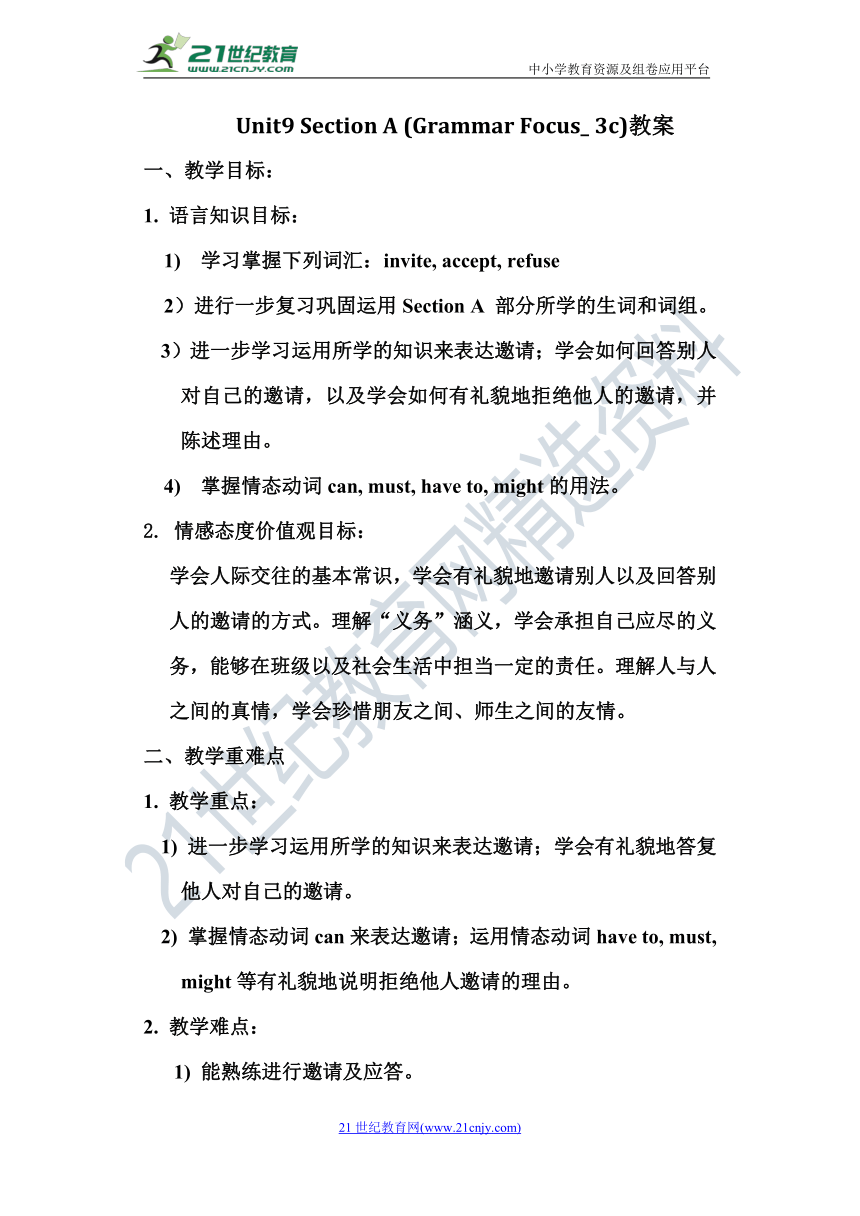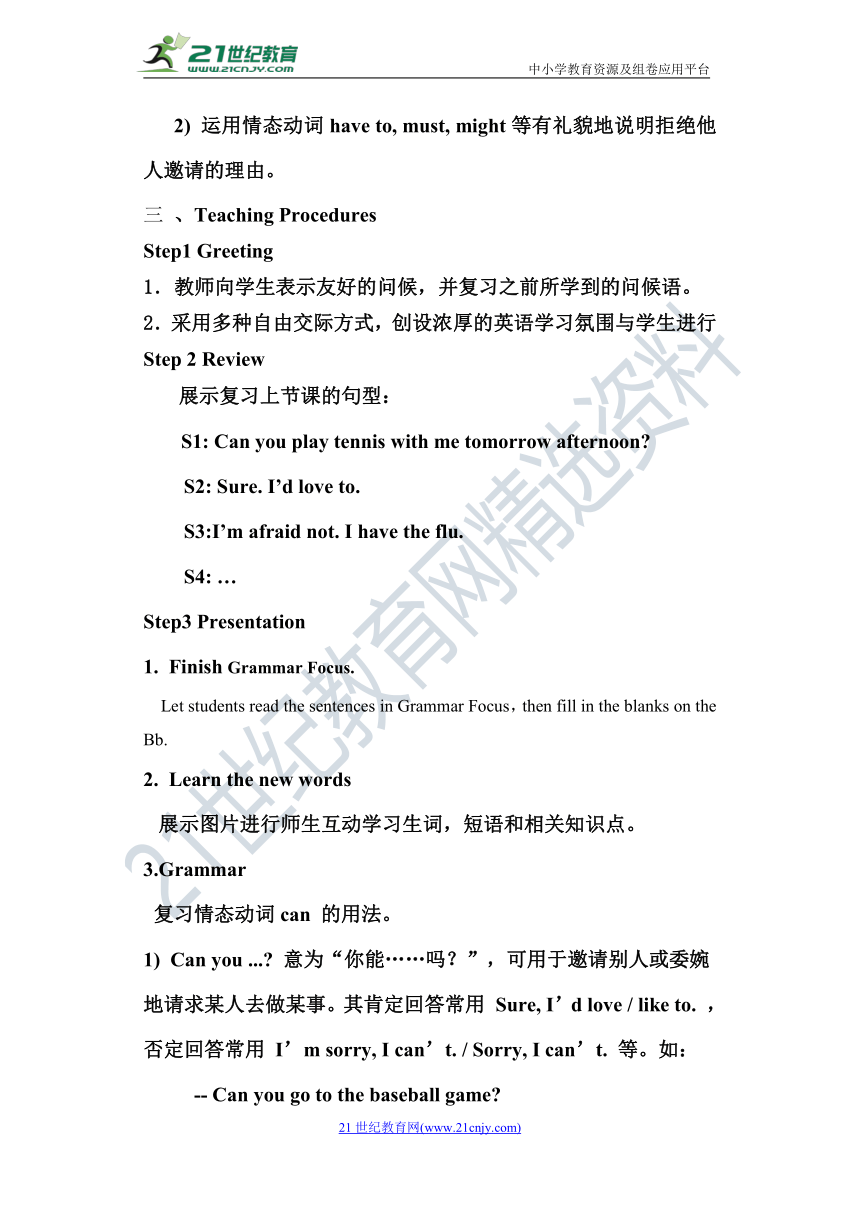【新课标】Unit9 Can you come to my party Section A (Grammar Focus-3c)教案
文档属性
| 名称 | 【新课标】Unit9 Can you come to my party Section A (Grammar Focus-3c)教案 |

|
|
| 格式 | doc | ||
| 文件大小 | 1.1MB | ||
| 资源类型 | 试卷 | ||
| 版本资源 | 人教新目标(Go for it)版 | ||
| 科目 | 英语 | ||
| 更新时间 | 2022-11-22 13:36:58 | ||
图片预览



文档简介
中小学教育资源及组卷应用平台
Unit9 Section A (Grammar Focus_ 3c)教案
一、教学目标:
1. 语言知识目标:
1) 学习掌握下列词汇:invite, accept, refuse
2)进行一步复习巩固运用Section A 部分所学的生词和词组。
3)进一步学习运用所学的知识来表达邀请;学会如何回答别人对自己的邀请,以及学会如何有礼貌地拒绝他人的邀请,并陈述理由。
4) 掌握情态动词can, must, have to, might的用法。
2. 情感态度价值观目标:
学会人际交往的基本常识,学会有礼貌地邀请别人以及回答别人的邀请的方式。理解“义务”涵义,学会承担自己应尽的义务,能够在班级以及社会生活中担当一定的责任。理解人与人之间的真情,学会珍惜朋友之间、师生之间的友情。
二、教学重难点
1. 教学重点:
1) 进一步学习运用所学的知识来表达邀请;学会有礼貌地答复他人对自己的邀请。
2) 掌握情态动词can来表达邀请;运用情态动词have to, must, might等有礼貌地说明拒绝他人邀请的理由。
2. 教学难点:
1) 能熟练进行邀请及应答。
2) 运用情态动词have to, must, might等有礼貌地说明拒绝他人邀请的理由。
三 、Teaching Procedures
Step1 Greeting
1.教师向学生表示友好的问候,并复习之前所学到的问候语。
2.采用多种自由交际方式,创设浓厚的英语学习氛围与学生进行
Step 2 Review
展示复习上节课的句型:
S1: Can you play tennis with me tomorrow afternoon
S2: Sure. I’d love to.
S3:I’m afraid not. I have the flu.
S4: …
Step3 Presentation
Finish Grammar Focus.
Let students read the sentences in Grammar Focus,then fill in the blanks on the Bb.
Learn the new words
展示图片进行师生互动学习生词,短语和相关知识点。
3.Grammar
复习情态动词can 的用法。
Can you ... 意为“你能……吗?”,可用于邀请别人或委婉地请求某人去做某事。其肯定回答常用 Sure, I’d love / like to. ,否定回答常用 I’m sorry, I can’t. / Sorry, I can’t. 等。如:
-- Can you go to the baseball game
你能去参加棒球比赛吗?
-- I’m sorry, I can’t. 对不起,我不能。
情态动词have to与其他的情态动词can,may,must和should 不同。
这4个情态动词没有人称的变化, 而have to有。它的第三人称单数为“has to”。
这4个情态动词在一般疑问句中将它们放在句首, 在否定句中直接在他们后边加not即可。
have to 与 must
二者都有“必须”之意,但 have to 表示“客观上的需要”,有人称和时态的变化,否定形式为 don’t / doesn’t / didn’t have to (没必要);must 表示“主观上的要求”,无人称和时态的变化,否定回答一般用 needn’t 或 don't have to (不必)。mustn’t 表示“禁止”。如:
4. Finish3a
Complete the answers with might and one of the phrases in the box.
Finish3b
Complete the sentences below. Use the words in brackets to help you.
Finish3c Group work
Write down everything you have to do next week. Choose a day and time to have a party. Then invite classmates to your party.
A: Can you come to my party on Saturday afternoon
B: Sure. I’d love to.
B: I’m sorry. I must practice the violin on Saturday afternoon.
B: I’m afraid not. I have the flu.
7.Summary
师生互动总结归纳本节课的重点内容。
8. Exercise
Let students work in group and discuss then finish the exercise on the Bb.
Step4 Homework
1. Recite the words and the useful expressions.
2. Read and recite the conversation in 3c.
Step5 板书设计
Unit9Can you come to my party
Section A (Grammar Focus-3c)
Grammar:
情态动词can 的用法小结:
Can you ... 意为“你能……吗?”,可用于邀请别人或委婉地请求某人去做某事。其肯定回答常用 Sure, I’d love / like to. ,否定回答常用 I’m sorry, I can’t. / Sorry, I can’t. 等。如:
-- Can you go to the baseball game
你能去参加棒球比赛吗?
-- I’m sorry, I can’t. 对不起,我不能。
情态动词have to与其他的情态动词can,may,must和should 不同。
这4个情态动词没有人称的变化, 而have to有。它的第三人称单数为“has to”。
这4个情态动词在一般疑问句中将它们放在句首, 在否定句中直接在他们后边加not即可。
have to 与 must
二者都有“必须”之意,但 have to 表示“客观上的需要”,有人称和时态的变化,否定形式为 don’t / doesn’t / didn’t have to (没必要);must 表示“主观上的要求”,无人称和时态的变化,否定回答一般用 needn’t 或 don't have to (不必)。mustn’t 表示“禁止”。
HYPERLINK "http://21世纪教育网(www.21cnjy.com)
" 21世纪教育网(www.21cnjy.com)
Unit9 Section A (Grammar Focus_ 3c)教案
一、教学目标:
1. 语言知识目标:
1) 学习掌握下列词汇:invite, accept, refuse
2)进行一步复习巩固运用Section A 部分所学的生词和词组。
3)进一步学习运用所学的知识来表达邀请;学会如何回答别人对自己的邀请,以及学会如何有礼貌地拒绝他人的邀请,并陈述理由。
4) 掌握情态动词can, must, have to, might的用法。
2. 情感态度价值观目标:
学会人际交往的基本常识,学会有礼貌地邀请别人以及回答别人的邀请的方式。理解“义务”涵义,学会承担自己应尽的义务,能够在班级以及社会生活中担当一定的责任。理解人与人之间的真情,学会珍惜朋友之间、师生之间的友情。
二、教学重难点
1. 教学重点:
1) 进一步学习运用所学的知识来表达邀请;学会有礼貌地答复他人对自己的邀请。
2) 掌握情态动词can来表达邀请;运用情态动词have to, must, might等有礼貌地说明拒绝他人邀请的理由。
2. 教学难点:
1) 能熟练进行邀请及应答。
2) 运用情态动词have to, must, might等有礼貌地说明拒绝他人邀请的理由。
三 、Teaching Procedures
Step1 Greeting
1.教师向学生表示友好的问候,并复习之前所学到的问候语。
2.采用多种自由交际方式,创设浓厚的英语学习氛围与学生进行
Step 2 Review
展示复习上节课的句型:
S1: Can you play tennis with me tomorrow afternoon
S2: Sure. I’d love to.
S3:I’m afraid not. I have the flu.
S4: …
Step3 Presentation
Finish Grammar Focus.
Let students read the sentences in Grammar Focus,then fill in the blanks on the Bb.
Learn the new words
展示图片进行师生互动学习生词,短语和相关知识点。
3.Grammar
复习情态动词can 的用法。
Can you ... 意为“你能……吗?”,可用于邀请别人或委婉地请求某人去做某事。其肯定回答常用 Sure, I’d love / like to. ,否定回答常用 I’m sorry, I can’t. / Sorry, I can’t. 等。如:
-- Can you go to the baseball game
你能去参加棒球比赛吗?
-- I’m sorry, I can’t. 对不起,我不能。
情态动词have to与其他的情态动词can,may,must和should 不同。
这4个情态动词没有人称的变化, 而have to有。它的第三人称单数为“has to”。
这4个情态动词在一般疑问句中将它们放在句首, 在否定句中直接在他们后边加not即可。
have to 与 must
二者都有“必须”之意,但 have to 表示“客观上的需要”,有人称和时态的变化,否定形式为 don’t / doesn’t / didn’t have to (没必要);must 表示“主观上的要求”,无人称和时态的变化,否定回答一般用 needn’t 或 don't have to (不必)。mustn’t 表示“禁止”。如:
4. Finish3a
Complete the answers with might and one of the phrases in the box.
Finish3b
Complete the sentences below. Use the words in brackets to help you.
Finish3c Group work
Write down everything you have to do next week. Choose a day and time to have a party. Then invite classmates to your party.
A: Can you come to my party on Saturday afternoon
B: Sure. I’d love to.
B: I’m sorry. I must practice the violin on Saturday afternoon.
B: I’m afraid not. I have the flu.
7.Summary
师生互动总结归纳本节课的重点内容。
8. Exercise
Let students work in group and discuss then finish the exercise on the Bb.
Step4 Homework
1. Recite the words and the useful expressions.
2. Read and recite the conversation in 3c.
Step5 板书设计
Unit9Can you come to my party
Section A (Grammar Focus-3c)
Grammar:
情态动词can 的用法小结:
Can you ... 意为“你能……吗?”,可用于邀请别人或委婉地请求某人去做某事。其肯定回答常用 Sure, I’d love / like to. ,否定回答常用 I’m sorry, I can’t. / Sorry, I can’t. 等。如:
-- Can you go to the baseball game
你能去参加棒球比赛吗?
-- I’m sorry, I can’t. 对不起,我不能。
情态动词have to与其他的情态动词can,may,must和should 不同。
这4个情态动词没有人称的变化, 而have to有。它的第三人称单数为“has to”。
这4个情态动词在一般疑问句中将它们放在句首, 在否定句中直接在他们后边加not即可。
have to 与 must
二者都有“必须”之意,但 have to 表示“客观上的需要”,有人称和时态的变化,否定形式为 don’t / doesn’t / didn’t have to (没必要);must 表示“主观上的要求”,无人称和时态的变化,否定回答一般用 needn’t 或 don't have to (不必)。mustn’t 表示“禁止”。
HYPERLINK "http://21世纪教育网(www.21cnjy.com)
" 21世纪教育网(www.21cnjy.com)
同课章节目录
- Unit 1 Where did you go on vacation?
- Section A
- Section B
- Unit 2 How often do you exercise?
- Section A
- Section B
- Unit 3 I'm more outgoing than my sister.
- Section A
- Section B
- Unit 4 What's the best movie theater?
- Section A
- Section B
- Unit 5 Do you want to watch a game show?
- Section A
- Section B
- Unit 6 I'm going to study computer science.
- Section A
- Section B
- Unit 7 Will people have robots?
- Section A
- Section B
- Unit 8 How do you make a banana milk shake?
- Section A
- Section B
- Unit 9 Can you come to my party?
- Section A
- Section B
- Unit 10 If you go to the party, you'll have a grea
- Section A
- Section B
